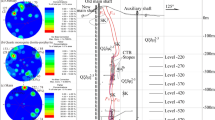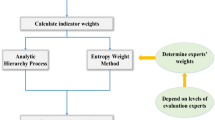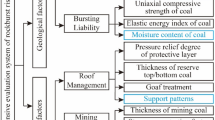Abstract
In order to precisely predict the hazard degree of goaf (HDG), the RS-TOPSIS model was built based on the results of expert investigation. To evaluate the HDG in the underground mine, five structure size factors, i.e. goaf span, exposed area, goaf height, goaf depth, and pillar width, were selected as the evaluation indexes. And based on rough dependability in rough set (RS) theory, the weights of evaluation indexes were identified by calculating rough dependability between evaluation indexes and evaluation results. Fourty goafs in some mines of western China, whose indexes parameters were measured by cavity monitoring system (CMS), were taken as evaluation objects. In addition, the characteristic parameters of five grades’ typical goafs were built according to the interval limits value of single index evaluation. Then, using the technique for order preference by similarity to ideal solution (TOPSIS), five-category classification of HDG was realized based on closeness degree, and the HDG was also identified. Results show that the five-category identification of mine goafs could be realized by RS-TOPSIS method, based on the structure-scale-effect. The classification results are consistent with those of numerical simulation based on stress and displacement, while the coincidence rate is up to 92.5%. Furthermore, the results are more conservative to safety evaluation than numerical simulation, thus demonstrating that the proposed method is more easier, reasonable and more definite for HDG identification.
Similar content being viewed by others
References
GONG Feng-qiang, LI Xi-bing, DONG Long-jun. Underground goaf risk evaluation based on uncertainty measurement theory [J]. Chinese Journal of Rock Mechanics and Engineering, 2008, 27(2): 321–330. (in Chinese)
CHEN Qing-fa. Study on synergism of hidden danger resources mining and goafs treatment [D]. Changsha: Central South University, 2009. (in Chinese)
XU Bi-gen, HUANG Ying-hua, LIU Xiao-lin. Influence of top-safeguarding layer on stability of mined-out area in gypsum mines [J]. Mining Research and Development, 2007, 27(5): 20–22. (in Chinese)
FENNER T. Ground penetrating radar for identification of mine tunnels and abandoned mine stops [J]. Mining Engineering, 1995, 47(3): 280–284.
DAVID R H, THOMAS L V, MATTHEW J D, KANAAN H. Advanced techniques in site characterization and mining hazard detection for the underground coal industry [J]. International Journal of Coal Geology, 2002, 50(14): 275–301.
HUBER D, VANDAPEL N. Automatic 3D underground mine mapping [J]. International Journal of Robotics Research, 2005, 25(1): 7–17.
LI Ke-gang, HOU Ke-peng, XIONG Ting-wei. Hazard identification of goaf in metal-mines based on extension theory [J]. Journal of Safety and Environment, 2009, 9(2): 169–172.
DUAN Yu. Fuzzy synthetic assessment of the danger degree of mined-out area disaster [D]. Changsha: Central South University, 2005. (in Chinese)
WANG Xin-min, DING De-qiang, DUAN Yu. Application of the grey relation analysis in the evaluation of the risk degree of the underground mined-out stopes [J]. Journal of Safety Science and Technology, 2006, 2(4): 35–39. (in Chinese)
GONG Feng-qiang, LIU Ke-wei, LI Zhi-guo. The bayes discriminant method for forecasting the stability of underground goaf [J]. Journal of Mining & Safety Engineering, 2010, 27(1): 30–39. (in Chinese)
LIU Xi-ling, SHANG Jun-long, ZHU Chuan-ming, HE Chun-lin, ZHAO Xing, DUAN Yu. Safety isolation layer calculation and stability analysis of cavity under open pit bench [J]. Metal Mine, 2011, 5: 141–145. (in Chinese)
HU Jian-hua, NING Yu-lin, ZHANG Xing-cheng, DU Xiang-hui, DENG Hong-wei. Risk factor forecast based on neural network and grey relational analysis on physical dimension effect of mine goafs [J]. Journal of Central South University: Science and Technology, 2013, 44(3): 1122–1130. (in Chinese)
HWANG C L, YOON K. Multiple attribute decision making-methods and applications, a state of the art survey [M]. New York: Springer-Verlag, 1981: 35–40.
PARKAN C, WU M L. Decision-making and performance measurement models with applications to robot selection [J]. Computers & Industrial Engineering, 1999, 36(3): 503–523.
GUAN Q C, LI S, YANG W. Evaluation of passenger services of airports using AHP and TOPSIS [C]// Proceeding: Computer Science Engineering and Applications. Orlando, FL: IEEE Press, 2003: 27–30.
YANG Yong-an, FENG Zu-ren, ZHANG Hong-wei, WU Yun-he. An approach to optimizing the initial orbital elements of spacecraft based on TOPSIS method. [J]. Journal of Astronautics, 2006, 27(4): 700–703.
CHENG Jin, TAN Jian-rong, YU Jia-hong. Multi-objective robust optimization of injection molding process parameters based on TOPSIS [J]. Journal of Mechanical Engineering, 2011, 47(6): 27–32.
PAWLAK Z. Rough sets [J]. International Journal of Computer and Information Sciences, 1982, 11(5): 341–356.
PAWLAK Z. Rough set approach to knowledge-based decision support [J]. 1997, 99(23): 48–57.
ZHANG Wen-xiu, WU Wei-zhi, LIANG Ji-ye. Rough sets theory and method [M]. Beijing: Science Press, 2006: 8–20. (in Chinese)
ZDZISLWA PAWLAK. Rough sets and intelligent data analysis [J]. Information Sciences, 2002, 147: 1–12.
XU Jiu-ping, WU Wei. Multiple attribute decision making theory and methods [M]. Beijing: Tsinghua University Press, 2006: 28–30. (in Chinese)
GOLESTANIFAR M, GOSHTASBI K, JAFARIAN M, ADNANI S. A multi-dimensional approach to the assessment of tunnel excavation methods [J]. International Journal of Rock Mechanics & Mining Sciences, 2011, 48(7): 1077–1085.
CHAMODRAKAS I, MARTAKOS D. A utility-based fuzzy TOPSIS method for energy efficient network seclection in heterogeneous wireless networks [J]. Applied Soft Computing, 2011, 11(4): 3734–3743.
XU Guo-yuan, YAN Chang-bin. Numerical simulation for influence of excavation and blasting vibration on stability of mined-out area [J]. Journal of Central South University of Technology, 2006, 13(5): 577–583.
Author information
Authors and Affiliations
Corresponding author
Additional information
Foundation item: Project(51074178) supported by the National Natural Science Foundation of China; Project(2011ssxt274) supported by the Graduated Students’ Research and Innovation Foundation of Central South University of China; Project(2011QNZT087) supported by the Graduated Students’ Free Exploration Foundation of Central South University of China; Project(1343-76140000011) supported by Scholarship Award for Excellent Doctoral Student granted by Ministry of Education, China
Rights and permissions
About this article
Cite this article
Hu, Jh., Shang, Jl., Zhou, Kp. et al. Hazard degree identification of goafs based on scale effect of structure by RS-TOPSIS method. J. Cent. South Univ. 22, 684–692 (2015). https://doi.org/10.1007/s11771-015-2571-1
Received:
Accepted:
Published:
Issue Date:
DOI: https://doi.org/10.1007/s11771-015-2571-1




